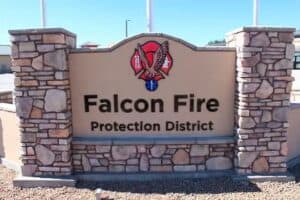When the Falcon Fire Department was formed in 1975, technology and communications were different from what we have today. Corded telephones with rotary dials were the norm in many households. Anyone who needed emergency help had to know the right number to call. Falcon firefighters used telephone calling trees to alert each other to alarms, and wrote incident reports by hand.Fast forward 40 years. In the digital age, a growing number of people rely on cell phones for communications; 911 is the easily remembered emergency number; and Falcon firefighters use smart phones, satellite mapping and computers in their day-to-day operations. All of these technology advancements have improved fire department operations and the services provided by first responders in the Falcon area.Dispatching then …FFPD Deputy Chief Jeff Petersma, whose father, Chuck Petersma, was a founding member of the Falcon Fire Department, described the early days of departmental communications. When Falcon Fire Department began operations in July 1975, a handful of Plectron emergency alerting radio receivers were issued to select volunteer firefighters. El Paso County Sheriffís Office dispatchers would send out a tone to activate the Plectron, and then follow up with a radio transmission to relay alarm information. The volunteers with the Plectrons were each responsible for notifying other volunteers via an established calling tree. Often, spouses would make those calls while the firefighters headed out to deal with the emergency.As technology progressed and department funding increased, some department members were issued radios that could sound alerts and monitor radio traffic, but not transmit. These were eventually replaced with standard two-way radios. All volunteers were issued Minitor pagers that functioned much like the Plectrons. The pagers, which were about the size of a deck of cards, sounded an audible alert followed by radio traffic about the incident. Alphanumeric pagers later replaced the Minitors.… and nowWhen someone calls 911 to report an emergency within the boundaries of the Falcon Fire Protection District, the call is routed to the El Paso County Sheriffís Office dispatch center. EPSO dispatchers then notify Falcon responders using an automated system that activates alerting systems at the fire stations; sends an alert message to department-issued pagers and member smart phones enrolled to receive those text messages; and transmits dispatch information to mobile data computer (MDC) systems installed on fire apparatus.Digital maps and incident reportsWithout the benefit of GPS (global positioning system) technology, firefighters once relied on thick binders containing pages of maps. Now, they rely on GPS data accessed through MDCs or smart phones to guide them to unfamiliar locations. As a backup, fire department vehicles still carry map books, but today they are smaller books provided by a commercial vendor.When an incident is over, paperwork must still be done. Before computers became commonplace in fire stations, reports were handwritten or typed on mimeographed forms. Now, when dispatchers receive a 911 call, a computerized report is generated that documents incident information. When Falcon personnel return to the fire station, they use this data to complete their own incident reports; using specialized computer software.Technology changes how emergencies are reportedPetersma said the development of services such as OnStar, which helps motorists connect with emergency services in the event of a crash or medical emergency, have changed the way some emergencies are reported. Medical alert systems such as Life Alert allow people to call for help when they are unable to reach a phone because of a fall or medical condition. More homes have monitored fire alarm systems installed, which provide early warning to occupants and automatically summon firefighters. ìThatís all changed the way we are notified,î Petersma said.But perhaps nothing has driven change more than the cell phone. Since many people who have cell phones carry them or keep them nearby,ìThe ability to call 911 is right there,î Petersma said.Call 911, not the fire stationThe three-digit number ì911î was established as a single, universal number to call for any kind of emergency assistance in the United States. Previously, there were often different numbers to call for different types of emergencies (police, fire, medical, etc.). According to the El Paso-Teller County 911 Authority website (http://elpasoteller911.org), the U.S. Congress first passed legislation to designate 911 as a standard emergency number nationwide in 1968.The Falcon Fire Protection District routinely receives calls for emergency assistance directly at its stations. However, Petersma encourages people to call 911 instead of calling the local fire station. Through the Enhanced 911 system (support for wireless phones), he said dispatchers can provide additional instructions to callers like how to control severe bleeding or perform CPR. Calling 911 also prevents unnecessary delays that can occur when personnel are away from the station on another call or at training, unable to answer the station phone.Registering for emergency notificationsThe ability to receive emergency warnings and notifications by phone or text message is crucial to staying safe. Because of changes to the emergency notification system, the El Paso-Teller County 911 Authority is asking everyone who registered for the Emergency Notification System prior to July 2013 to create a new account.
- Go to http://elpasoteller911.org and select ìsign upî on the registration page.
- Log in using the existing user name and password. If login is successful, no further action is needed.
- If an error message appears indicating the email or password is invalid, press the sign up button and create a new account.




